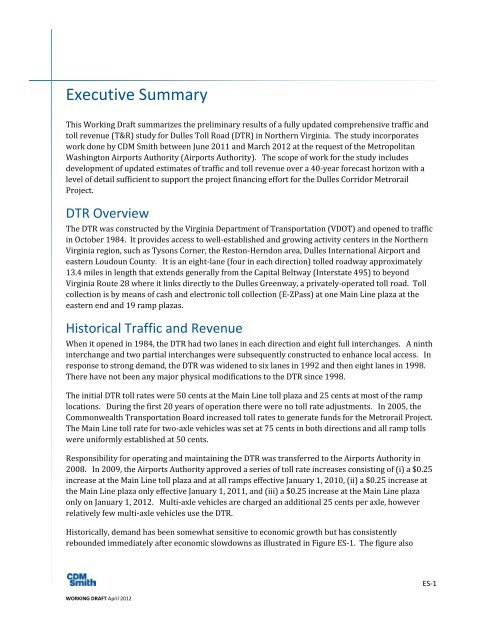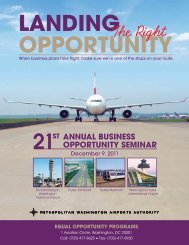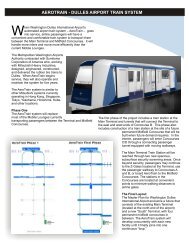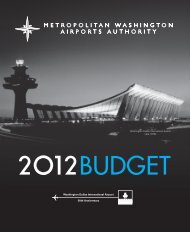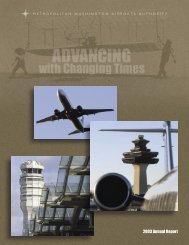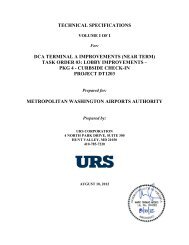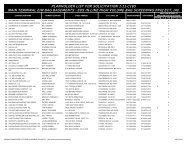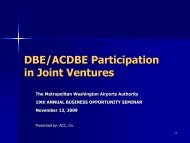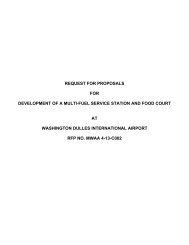Comprehensive Traffic and Revenue Study 2012 Update
Comprehensive Traffic and Revenue Study 2012 Update
Comprehensive Traffic and Revenue Study 2012 Update
- No tags were found...
You also want an ePaper? Increase the reach of your titles
YUMPU automatically turns print PDFs into web optimized ePapers that Google loves.
Executive SummaryThis Working Draft summarizes the preliminary results of a fully updated comprehensive traffic <strong>and</strong>toll revenue (T&R) study for Dulles Toll Road (DTR) in Northern Virginia. The study incorporateswork done by CDM Smith between June 2011 <strong>and</strong> March <strong>2012</strong> at the request of the MetropolitanWashington Airports Authority (Airports Authority). The scope of work for the study includesdevelopment of updated estimates of traffic <strong>and</strong> toll revenue over a 40-year forecast horizon with alevel of detail sufficient to support the project financing effort for the Dulles Corridor MetrorailProject.DTR OverviewThe DTR was constructed by the Virginia Department of Transportation (VDOT) <strong>and</strong> opened to trafficin October 1984. It provides access to well-established <strong>and</strong> growing activity centers in the NorthernVirginia region, such as Tysons Corner, the Reston-Herndon area, Dulles International Airport <strong>and</strong>eastern Loudoun County. It is an eight-lane (four in each direction) tolled roadway approximately13.4 miles in length that extends generally from the Capital Beltway (Interstate 495) to beyondVirginia Route 28 where it links directly to the Dulles Greenway, a privately-operated toll road. Tollcollection is by means of cash <strong>and</strong> electronic toll collection (E-ZPass) at one Main Line plaza at theeastern end <strong>and</strong> 19 ramp plazas.Historical <strong>Traffic</strong> <strong>and</strong> <strong>Revenue</strong>When it opened in 1984, the DTR had two lanes in each direction <strong>and</strong> eight full interchanges. A ninthinterchange <strong>and</strong> two partial interchanges were subsequently constructed to enhance local access. Inresponse to strong dem<strong>and</strong>, the DTR was widened to six lanes in 1992 <strong>and</strong> then eight lanes in 1998.There have not been any major physical modifications to the DTR since 1998.The initial DTR toll rates were 50 cents at the Main Line toll plaza <strong>and</strong> 25 cents at most of the ramplocations. During the first 20 years of operation there were no toll rate adjustments. In 2005, theCommonwealth Transportation Board increased toll rates to generate funds for the Metrorail Project.The Main Line toll rate for two-axle vehicles was set at 75 cents in both directions <strong>and</strong> all ramp tollswere uniformly established at 50 cents.Responsibility for operating <strong>and</strong> maintaining the DTR was transferred to the Airports Authority in2008. In 2009, the Airports Authority approved a series of toll rate increases consisting of (i) a $0.25increase at the Main Line toll plaza <strong>and</strong> at all ramps effective January 1, 2010, (ii) a $0.25 increase atthe Main Line plaza only effective January 1, 2011, <strong>and</strong> (iii) a $0.25 increase at the Main Line plazaonly on January 1, <strong>2012</strong>. Multi-axle vehicles are charged an additional 25 cents per axle, howeverrelatively few multi-axle vehicles use the DTR.Historically, dem<strong>and</strong> has been somewhat sensitive to economic growth but has consistentlyrebounded immediately after economic slowdowns as illustrated in Figure ES-1. The figure alsoWORKING DRAFT April <strong>2012</strong>ES-1


